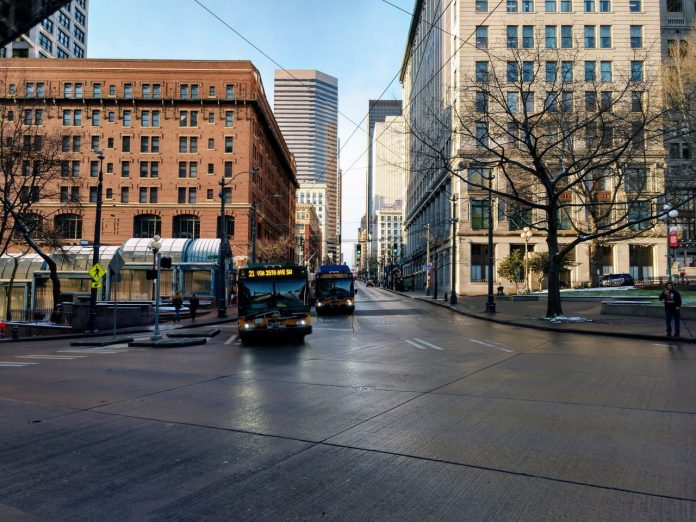
King County Executive Dow Constantine has sided with those seeking to site light rail outside of the Chinatown-International District (CID). In his annual State of the County speech yesterday, Constantine backed using redevelopment of the King County Administration Building to site the new south downtown station as proposed in the ‘North of CID’ alternative — a last-minute addition to Link expansion planning.
“Sound Transit is considering the shuttered Administration Building as the site for a new Link Light Rail station. If selected, we should make the most of this opportunity,” Constantine said in his speech. “Members of the council, rather than selling the land, I propose we keep it, and allow Sound Transit to build their new tunnel and station below. Their investment in infrastructure could set the groundwork for new development above, and jump start the reinvention of this old hillside.”
Putting the station at the County-owned site at 4th Avenue and James Street would entail a worse transfer experience for many riders across the system. Pioneer Square would become the major transfer station on the south side of Seattle’s downtown core rather than the more natural transfer point at the International District/Chinatown Station, which could incorporate Union Station as well as Sounder, Amtrak, First Hill Streetcar, and intercity buses. North of CID means the new light rail line extending to Ballard would not have a station in the heart of CID or Midtown, on the doorstep of First Hill, a neighborhood which would continue to see light rail get farther rather than closer.
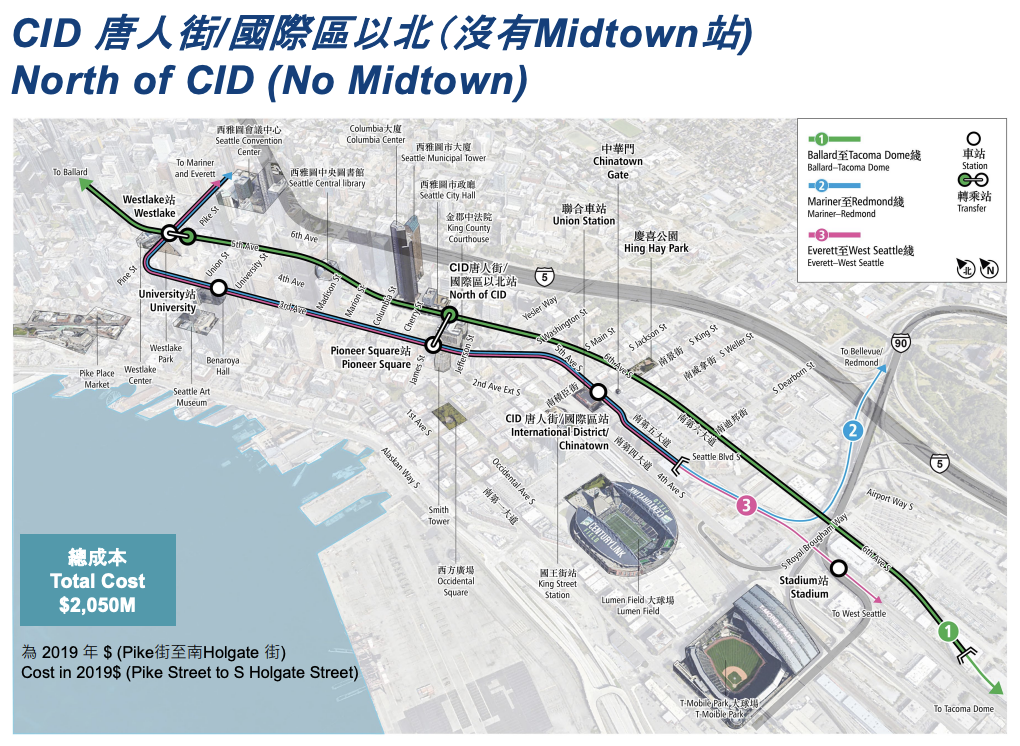
Despite these drawbacks, Constantine called siting the station at the Administration Building a “win-win” allowing “a world-class transit system.” The Urbanist‘s Stephen Fesler had a different take, arguing the move violated “first principles” of transit and would be “a serious blow to the transit system and forever punish transit riders by increasing travel times” — as much as 10 minutes in some scenarios.
Likewise rail advocacy group Seattle Subway is staunchly in favor of a shallower 4th Avenue Station which could activate Union Station and offer great transfers between transit services. Seattle Subway spokesperson Ben Broesamle criticized the proposal by Constantine.
“This proposal is full of systemic flaws: replacing a few years of undesirable construction with bad regional connectivity forever. It deletes an entire station in Midtown, it creates difficult access to Sounder and Amtrak, it makes elderly and disabled riders — along with everyone else — transfer two to four times for even the most basic transit journey,” Broesamle said. “These bad transfers hit Rainier Valley, South King County, and Pierce County riders the hardest.”
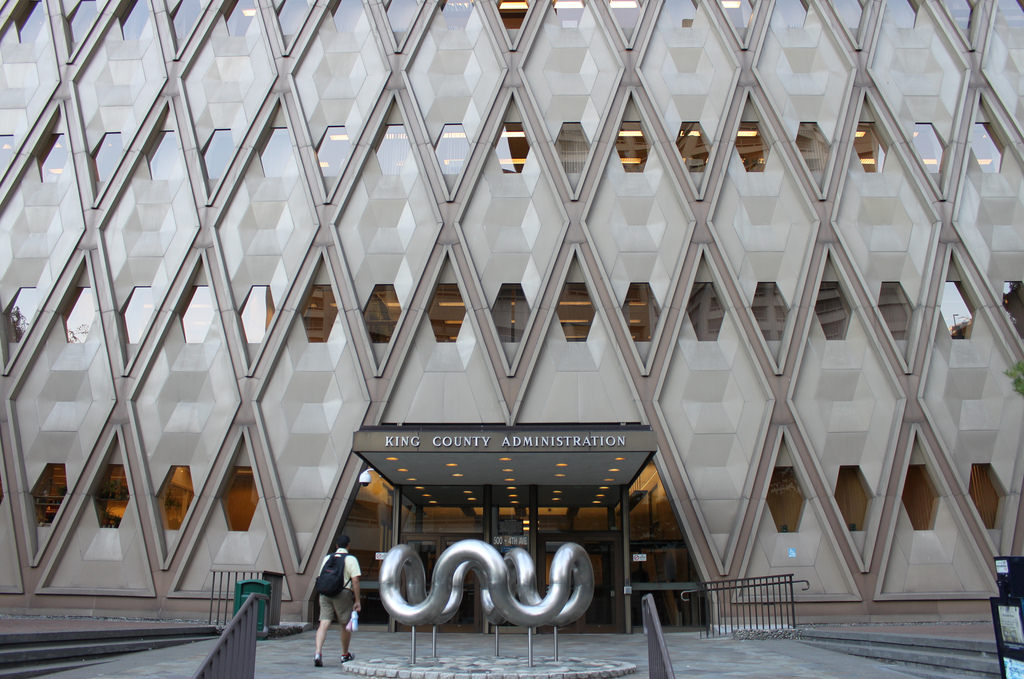
Seattle Subway expressed concerns that the County was putting expediency and its own real estate machinations ahead of the region and the city’s transit needs.
“While we understand King County’s desire to upgrade out-of-date public buildings in Pioneer Square, that desire isn’t a reason to make transit riders suffer in perpetuity,” Broesamle said. “There is no world in which the equitable thing to do is to disinvest in the CID, a historically disinvested community of color, so the county can solve its old-building problem and spend the money downtown instead.”
However, North of CID appears cheaper to build and may face less neighborhood pushback in the CID. That pushback, which centers around construction impacts and displacement pressure, includes prominent equity-focused nonprofit Puget Sound Sage, the CID Coalition, and several small businesses in the neighborhood.
The Sound Transit Board is set to vote later this month on the preferred alternative for the Downtown Seattle light rail segment of Ballard Link.
Alluding to the need to come to decision on a light rail alignment through Downtown Seattle, Constantine suggested the County’s Administration Building presented a way out of the conundrum and could serve as a light rail station site with publicly-owned transit-oriented development (TOD) added overhead.
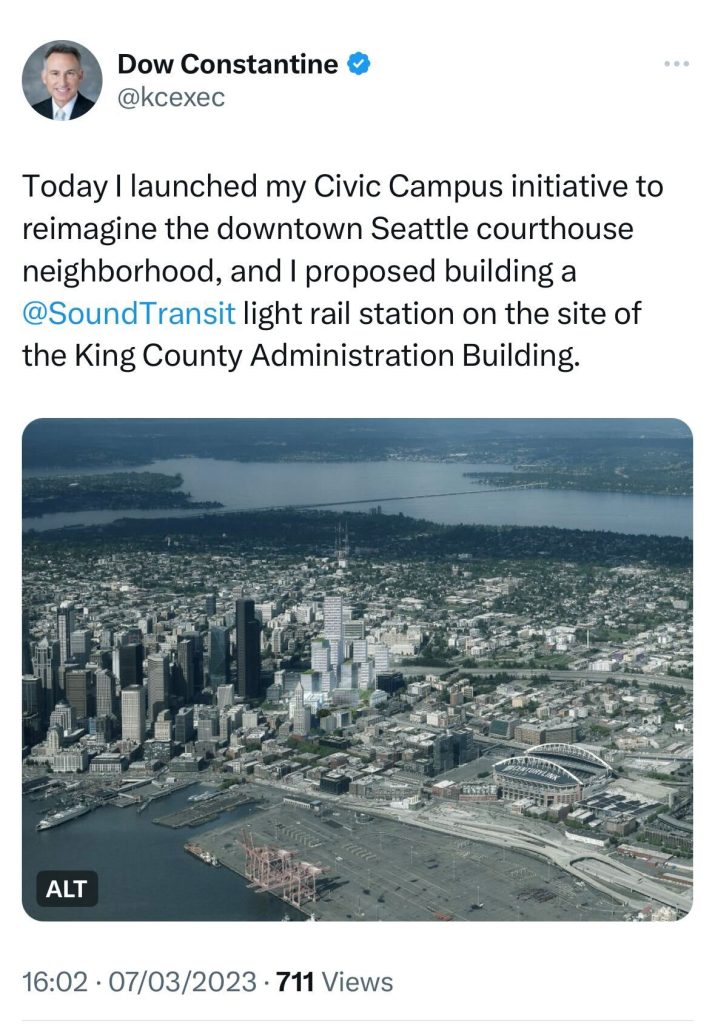
Such a station site would seem to avoid controversy from some quarters but could kick it up in others. Several CID organizations and leaders have supported putting a station at 4th Avenue, arguing it would be more convenient for neighborhood residents relying on transit to get around. Among that group is long-time community leaders Brien Chow and Betty Lau of the Chong Wa Benevolent Association who have launched a “Move Forward With 4th” coalition. Similarly, the First Hill Improvement Association has backed keeping the station in CID to avoid elimination of the Midtown Station, which is incompatible with the North of CID option.
Moreover, Seattle Subway suggested the switcheroo broke faith with voters and wouldn’t achieve equity aims.
“Voters approved a major multimodal transfer hub at Union Station,” Broesamle said. “What they are getting is the opposite of that. No global city worth its salt would do this. Bad transit is not equitable.”
The catch with 4th Avenue alternatives, however, is that Sound Transit has said the need to replace the 4th Avenue viaduct would add significantly to the project’s cost, lengthen construction times, and likely require the City of Seattle to chip in — a conversation that neither the Durkan nor Harrell Administrations have shown much interest in, let alone enthusiasm. The agency has pegged the added cost at $700 million for the shallow 4th Avenue alternative and $800 million for the ‘shallower’ 4th Avenue alternative.
Mayor Bruce Harrell has focused his recent comments at Sound Transit board meetings on avoiding construction impacts and costs imposed on the City of Seattle rather than grappling with what it would take to build the best option for transit riders.
Given the power he wields, Constantine’s announcement is a real blow to the prospects of a 4th Avenue station. For starters, Constantine is Chair of the Sound Transit Board. Plus, as county executive, he appoints the members of the King County delegation, which accounts for nine of 18 seats, meaning members that buck him must worry about getting replaced down the road. While the members from Pierce County and Snohomish County at times spar with King County’s delegation and counterbalance them, they’re also very concerned with building light rail to Tacoma and Everett as soon as possible and controlling costs in the Seattle segments, which North of CID could accomplish by jettisoning a station and avoiding the 4th Avenue viaduct issue.
Still, the CID station debate hasn’t followed a linear path thus far, so more twists could still be in store.
Dow Doubles Down on Dubious Downtown Development Delusion.
When it comes to the TOD potential of the site and the underutilized blocks of the County campus, it is theoretically enormous. A 100-story residential tower proposal has been floated two blocks away. Just next door on the Civic Square site, a 58-story housing proposal is shovel-ready and had been breaking ground until pandemic complications shuttered the site once more. The County campus is similarly zoned for skyscrapers.
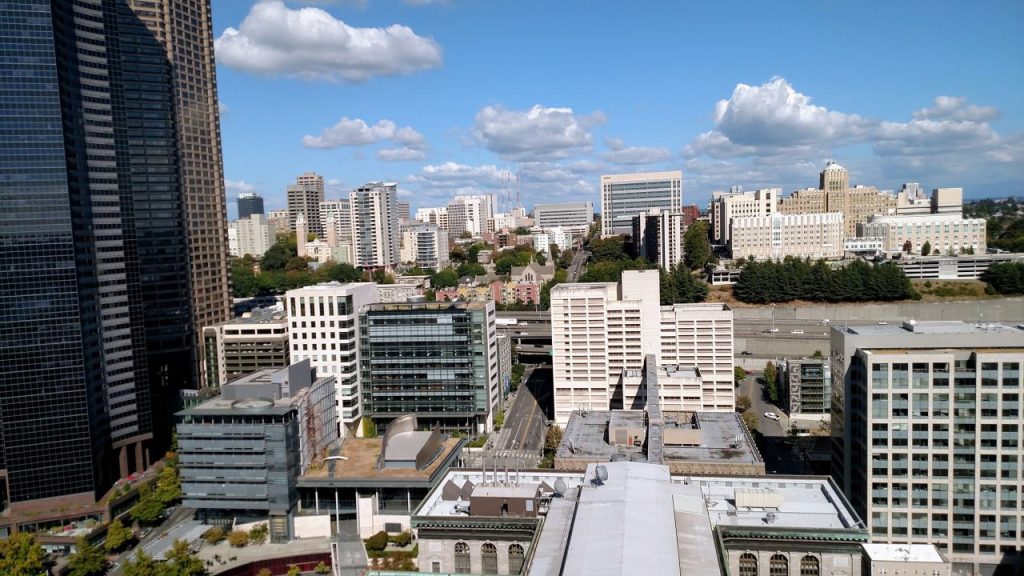
After the speech, Constantine tweet a graphic showing a redeveloped King County campus complex with one tower rivaling Columbia Center and reiterating “I proposed building a Sound Transit light rail station on the site of the King County Administration Building.” That tweet was subsequently deleted and replaced with one less committal about station preferences, and Constantine spokesperson Chase Gallagher also walked back the statement when reached for comment, declining to confirm Constantine preferred the North of CID alternative.
“The images shared yesterday basically illustrate the current zoning capacity of those blocks,” Gallagher said in an email. “As far as the rest of the civic campus plan, it’s really just the beginning and there will be a lot of conversation and collaboration from here to develop ideas and plans.”
Managing such a complex TOD project won’t be without its challenges. King County struggled to move its Northgate TOD site forward after a mixed-income proposal fell through and the agency pivoted to a smaller affordable housing proposal on a fraction of the site — leaving surface parking on the remainder of the site for now and the affordable housing still in the works two years after the station opened. Seattle Councilmember Debora Juarez (District 5) was extremely disappointed in the delays and bungled process and made it known in 2018 as the County was launching a second Request for Proposals process.
“I’m disappointed that Northgate may become the textbook example of how not to do transit-oriented development,” Juarez said at the time. “I thought we were going to be the shining example of how to do it.”
The County obviously hopes to be more nimble in this situation. It appears Constantine wants to keep the land in public hands and lease it to developers, and while that’s prudent for the long-term certainly, it adds another potential tripwire to negotiations with developers. And if the aim is to maximize affordable housing on the campus, that will likely take the County and its partners ponying up a ton of funding since building skyscrapers downtown entails very high building costs — generally beyond the means of nonprofit builders. Building out part of the campus to its zoned capacity would be an enormous undertaking.
Despite the Executive’s framing in his speech, the campus is already an excellent site for TOD whether or not Sound Transit selects the North of CID alternative. The existing Pioneer Square Station is already only a block and a half away and other proposed CID stations and Mid-Town alternatives would not be much further. The TOD makeover works in any scenario.
Downtown revitalization.
Beyond the news around the downtown light rail preferences, Constantine’s speech also touched on downtown revitalization, a looming budget crisis, and the potential of property tax reform.
Echoing Seattle Mayor Bruce Harrell, Constantine pointed to the need to reinvigorate Downtown Seattle and said he is launching a Civic Campus Initiative to look at renovating or repurposing buildings in the King County’s seven-block downtown campus. In the restoration camp, he put the century-old Yesler Building and King County Courthouse.
“The 1960s Administration building next door is vacant; the 1980s jail is obsolete,” Constantine said in prepared remarks. “On some of the most valuable real estate in this region, we have a nine to five workplace, rather than a 24-hour neighborhood. We have the chance to rethink and remake this vast urban tract in light of what it means to be a city today.”
As in Harrell’s recent State of the City speech, Constantine pointed to the need for more of nightlife and around-the-clock activation in downtown.
“This historic area can remain a center of local government, but it can also be so much more: A neighborhood with thousands of residents of all incomes, with shops and restaurants and gathering spaces; a place that enlivens and supports the surrounding neighborhoods,” Constantine said. “Public and private workplaces that reflect the way people work in this new era. It’s clear that we’re not simply going back to how things were — so let’s use this moment to go forward.”
The similarities with Harrell didn’t stop, as the speech offered broad strokes rather than concrete actions to bring about the reinvigorated downtown.
Property tax pinch causing budget crunch
Constantine warned of an impending budget shortfall of about $100 million per year and implored the state legislature to provide the County with greater tax authority by lifting the 1% cap on property tax increases. That cap, originally cooked up by conservative initiative huckster Tim Eyman, has greatly limited how local government can react to needed investments in social programs and infrastructure and has massively increased their reliance on property tax levy initiatives, even when it just comes to maintaining basic services.
A recent example of this is the billion-dollar mental health levy the County will send to the ballot in April to offer basic mental health services and stand up seven crisis centers.
The Washington State Legislature has a proposal, HB 1670, to tackle the problem by raising the 1% cap to 3%. It advanced out of committee in the House on a party-line vote, but faces the house-of-origin deadline today to clear a floor vote and pass to the other chamber or die this session.
“The legislature must take action this year, this session, to finally undo this shortsighted policy so that we can continue leading, continue investing, continue building the future we all want to see,” Constantine said.
Doug Trumm is publisher of The Urbanist. An Urbanist writer since 2015, he dreams of pedestrian streets, bus lanes, and a mass-timber building spree to end our housing crisis. He graduated from the Evans School of Public Policy and Governance at the University of Washington in 2019. He lives in Seattle's Fremont neighborhood and loves to explore the city by foot and by bike.


